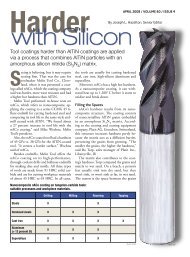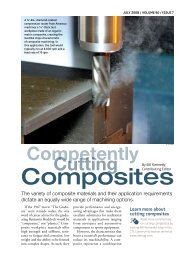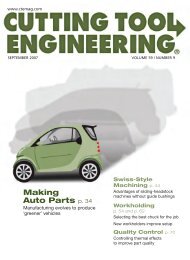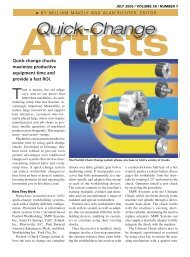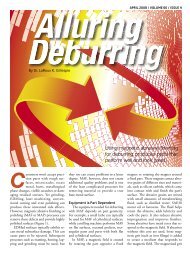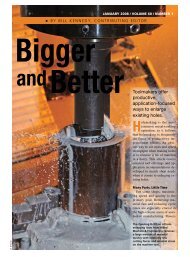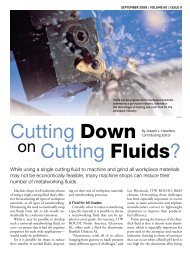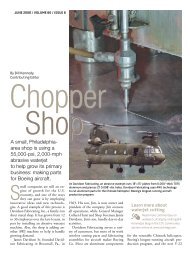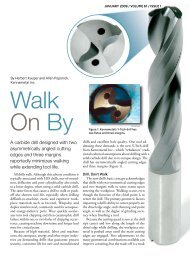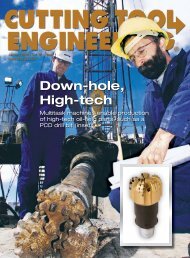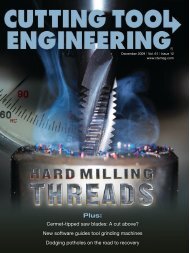Low-cost, portable, surface-roughness measurement gages help ...
Low-cost, portable, surface-roughness measurement gages help ...
Low-cost, portable, surface-roughness measurement gages help ...
You also want an ePaper? Increase the reach of your titles
YUMPU automatically turns print PDFs into web optimized ePapers that Google loves.
<strong>Low</strong>-<strong>cost</strong>, <strong>portable</strong>,<br />
<strong>surface</strong>-<strong>roughness</strong><br />
<strong>measurement</strong> <strong>gages</strong><br />
<strong>help</strong> users perform<br />
quick inspections on<br />
the shop floor.<br />
Even though grinding yields<br />
a better <strong>surface</strong> finish than<br />
milling and milling produces<br />
a better <strong>surface</strong> finish than<br />
sawing, all machining processes<br />
leave some <strong>surface</strong> irregularities<br />
on a part. Factors such as the cutting<br />
tool, machine tool condition,<br />
machining parameters, vibration<br />
and environmental factors influence<br />
these irregularities.<br />
High-precision parts usually<br />
require a high-quality finish.<br />
“Measuring <strong>surface</strong> finish is critical,<br />
especially for the aerospace<br />
industry,” said Ed Arruda, service<br />
manager at Fred V. Fowler Co.<br />
Inc., Newton, Mass. “Anybody<br />
making airplane parts has to<br />
measure the finish of the parts to<br />
make sure they are smooth enough to<br />
travel through the air at high speeds.”<br />
He added that for mating parts, such<br />
as those found in pumps, the <strong>surface</strong>s<br />
have to match exactly. “You want to<br />
take a <strong>surface</strong> <strong>measurement</strong> from both<br />
parts to make sure they have the same<br />
<strong>roughness</strong> finish.”<br />
To verify the <strong>surface</strong> finish is within<br />
spec, it must be measured. For <strong>surface</strong>s<br />
specified only by a <strong>roughness</strong> parameter,<br />
<strong>portable</strong>, battery-powered skidded<br />
APRIL 2005 / VOLUME 57 / NUMBER 4<br />
➤ BY SUSAN WOODS, FEATURES EDITOR<br />
Going<br />
<strong>gages</strong>—typically measuring about<br />
5"✕3"✕1" and weighing about 14 oz.—<br />
are available for $2,000 or less. These<br />
devices, which can measure in microinches<br />
or micrometers, have a metal<br />
or ruby skid—a rest attached to a<br />
probe—that rides across the <strong>surface</strong> of<br />
the part and a diamond-tipped stylus that<br />
moves up and down relative to that skid.<br />
For more sophisticated <strong>surface</strong>-finish<br />
<strong>measurement</strong>s, skidless <strong>gages</strong>, which<br />
start around $6,000, are available. In<br />
skidless <strong>gages</strong>, the probe moves relative<br />
to a reference <strong>surface</strong> inside the drive<br />
mechanism, so that the stylus is free to<br />
follow the full profile of the part.<br />
“With the skidless <strong>gages</strong>, you just<br />
have the diamond stylus touching the<br />
<strong>surface</strong>,” said Gene Ripa, applications<br />
engineer at Mahr Federal Inc., Providence,<br />
R.I. “A drive unit moves the diamond<br />
across the <strong>surface</strong> and it makes its<br />
<strong>measurement</strong> with respect to a precision<br />
slide that is built into the drive unit. The<br />
Carl Zeiss
Precision Devices<br />
rough going<br />
purpose of the skidless gage is to ‘see’<br />
everything of the <strong>surface</strong>, including the<br />
profile, waviness and <strong>roughness</strong>.”<br />
At the highest end are instruments<br />
that use optics and other noncontact<br />
methods to measure <strong>surface</strong> finish.<br />
A Skid in the Road<br />
With a skidded gage, the stylus reads<br />
the peaks and valleys and determines<br />
the <strong>roughness</strong> of the <strong>surface</strong>. The skidded<br />
gage is only intended to measure<br />
the <strong>roughness</strong> of the <strong>surface</strong> because<br />
the purpose of the skid is to make sure<br />
the waviness does not affect the <strong>roughness</strong><br />
reading.<br />
Skid<br />
Stylus<br />
In this simple view, the stylus rides on the<br />
<strong>surface</strong> and measures peaks and valleys relative<br />
to a skid, which also rides on the <strong>surface</strong>.<br />
“The skid is like a mechanical shoe<br />
that rides on the <strong>surface</strong>,” said Ripa.<br />
“The diamond stylus makes its <strong>measurement</strong><br />
with respect to the skid, rather<br />
than making its <strong>measurement</strong> with respect<br />
to the precision slide. So, the only<br />
reference is this ‘shoe,’or skid. The skid<br />
rides on the actual <strong>surface</strong> being measured.<br />
It will rise up and down on the<br />
waves but it won’t ‘see’ the<br />
waves. Its purpose is to remove<br />
the waves from the <strong>measurement</strong><br />
so that only <strong>roughness</strong> is measured.”<br />
Most skidded <strong>gages</strong> measure three<br />
<strong>surface</strong>-<strong>roughness</strong> parameters: average<br />
<strong>roughness</strong> (Ra); maximum <strong>roughness</strong><br />
depth (Rmax or Ry); and mean <strong>roughness</strong><br />
depth (Rz).<br />
Ra is an average of all the peaks and<br />
valleys that are symmetrical about the<br />
mean line.<br />
Rmax measures the vertical distance<br />
from the highest peak to the lowest valley<br />
within five sample lengths and selects<br />
the largest.<br />
Rz is based on the evaluation of five<br />
sample lengths, but instead of selecting<br />
Mahr Federal<br />
Pocket Surf <strong>portable</strong><br />
<strong>surface</strong>-<strong>roughness</strong> gage.<br />
the largest peak-to-valley distance of the<br />
five, it averages the five values.<br />
Ry is identical to Rmax, but is used<br />
when measuring less than five sample<br />
lengths.<br />
At a minimum, the operator must set<br />
the desired parameter to be measured<br />
and the desired cutoff. Typically,<br />
the parameter is evaluated at five<br />
times the cutoff length.<br />
“For instance, a cutoff of<br />
0.030" would be evaluated over<br />
0.150" with a total measured<br />
length of 0.180",” said Robert<br />
Wasilesky, business manager for<br />
SF&G team, Carl Zeiss Inc.,<br />
Thornwood, N.Y.<br />
Other Features<br />
For measuring holes or curved <strong>surface</strong>s,<br />
most gage manufacturers offer<br />
optional probes that attach to their<br />
<strong>gages</strong>. The <strong>gages</strong> also take <strong>measurement</strong>s<br />
from a variety of positions and<br />
several angles and measure horizontal<br />
and vertical <strong>surface</strong>s.<br />
Some even<br />
work upside down.<br />
Mahr Federal<br />
Portable<br />
<strong>surface</strong>-<strong>roughness</strong><br />
<strong>gages</strong> can be used on automotive parts.<br />
Most of these <strong>gages</strong> have digital displays<br />
and many also have recorders for<br />
printing the results. They also have RS-<br />
232 outputs for statistical process control<br />
applications and can be plugged into a<br />
PC for statistical analysis.<br />
Most <strong>gages</strong> also come with a <strong>surface</strong>-<strong>roughness</strong><br />
master. Upon receiving<br />
“We actually have people<br />
buying these systems to<br />
monitor the performance<br />
of their central machining<br />
processes themselves.”<br />
their instrument, and throughout the<br />
day or week, operators can check the<br />
master and make sure the gage is reading<br />
correctly. And if they need to calibrate<br />
the gage, they can.<br />
The Bad and the Good<br />
Skidded devices are limited somewhat<br />
because they only measure <strong>surface</strong><br />
<strong>roughness</strong>—not profiling features<br />
Surfcom 130A <strong>portable</strong><br />
<strong>surface</strong>-<strong>roughness</strong> gage.<br />
or waviness.<br />
“There is no doubt that in a lot of applications<br />
if you are just measuring <strong>surface</strong><br />
<strong>roughness</strong> you are not measuring<br />
enough,” said Wasilesky. “For example,<br />
on flat <strong>surface</strong>s where the intention<br />
is to seal, like the head deck on an engine<br />
block, if there is too much waviness,<br />
you might not have seal conformability<br />
and the system could leak.<br />
So if you are just measuring <strong>roughness</strong>,<br />
you might not be able to find that.”<br />
Another example would be “orange<br />
peel” on an automobile. “You can measure<br />
<strong>surface</strong> <strong>roughness</strong> on an automobile’s<br />
body panel and come up with<br />
<strong>roughness</strong> that is acceptable,” said<br />
Wasilesky. “But you still might have<br />
an orange peel effect because that is<br />
more visible as a waviness component<br />
than a <strong>roughness</strong> component.”<br />
Another drawback is that the skid<br />
can put enough pressure on a <strong>surface</strong> to<br />
burnish it.<br />
Also, the range and resolution of<br />
skidded <strong>gages</strong> are not as accurate as<br />
more sophisticated devices. Typical<br />
skidded <strong>gages</strong> cannot resolve accurately<br />
in fractions of a microinch, nor<br />
should they be used when measuring<br />
Carl Zeiss
Mahr Federal<br />
rough going<br />
<strong>surface</strong> <strong>roughness</strong> below<br />
10µin.<br />
The biggest drawback,<br />
according to Scott Robinson,<br />
technical support at L.S.<br />
Starrett Co.,Athol, Mass., is that these<br />
skidded devices “are very sensitive to<br />
being dropped or mishandled. Even<br />
though industry tries to make them as<br />
rugged as they can, they can’t prevent<br />
them from being dropped.”<br />
One of the biggest benefits to using a<br />
skidded device is a part can be measured<br />
on or off the machine. “That is a<br />
real benefit because if you are actually<br />
machining and you want a particular<br />
<strong>surface</strong> quality, not taking the part<br />
off the machine makes it a<br />
heck of a lot easier to do,”<br />
said Wasilesky.<br />
Portable <strong>surface</strong>-<strong>roughness</strong> <strong>gages</strong> can<br />
measure grooves.<br />
The following companies<br />
contributed to this report:<br />
Carl Zeiss Inc.<br />
(914) 747-1800<br />
www.zeiss.com<br />
Fred V. Fowler Co. Inc.<br />
(800) 788-2353<br />
www.fvfowler.com<br />
Mahr Federal Inc.<br />
(401) 784-3100<br />
www.mahr.com<br />
L.S. Starrett Co.<br />
(978) 249-3551<br />
www.starrett.com<br />
Portable<br />
sufrace-<strong>roughness</strong> <strong>gages</strong><br />
Mahr Federal<br />
can measure small holes.<br />
Even when more complex <strong>surface</strong><br />
<strong>measurement</strong>s are needed, skidded<br />
devices still have a place on the shop<br />
floor. A shop may have one skidless<br />
gage for manufacturing engineering and<br />
quality-assurance purposes, and make<br />
several skidded <strong>gages</strong> available to machinists.<br />
Once the machining process is<br />
established and confirmed<br />
on the skidless gage, machinists<br />
use the skidded<br />
<strong>gages</strong> strictly as a means of<br />
ensuring process stability.<br />
“We actually have people<br />
buying these systems to<br />
monitor the performance of<br />
their central machining<br />
processes themselves,” said<br />
Wasilesky. “If you collect<br />
enough data, you can see parameters<br />
and characteristics that match to different<br />
processes for a multiple-operation<br />
part. If you are turning and the <strong>surface</strong><br />
finish worsens, there comes a point<br />
where you know exactly when to<br />
change the tool if you are monitoring<br />
the process 100 percent. And on a grinding<br />
wheel, you know exactly when to<br />
redress. While most people use them to<br />
check part quality, I think their best use<br />
is for process control.<br />
“However, when you start changing<br />
your measuring process from one or<br />
two parts in a batch to measuring a<br />
greater number of parts in a batch, it becomes<br />
more labor-intensive. So to use it<br />
for process control means you need to<br />
increase the frequency of <strong>measurement</strong><br />
and people associate that with more<br />
labor. But the reality is you can make<br />
your process that much more efficient<br />
Surface <strong>roughness</strong><br />
glossary<br />
Cutoff—The sample length on the<br />
<strong>surface</strong> of a part that is measured.<br />
Evaluation length—The entire<br />
length of a profile over which data<br />
has been collected.<br />
Sample length—One evaluation<br />
length consists of several, usually<br />
five, sample lengths.<br />
Skid—A rest attached to the probe.<br />
Stylus—A cone-shaped spherical<br />
point made of diamond.<br />
Waviness—Repeating <strong>surface</strong><br />
irregularities with spacing greater<br />
than the <strong>roughness</strong>.<br />
while increasing overall quality,” said<br />
Wasilesky.<br />
Look Out<br />
There are certain desirable features<br />
in the skidded devices. One is a display<br />
that is visible in all lighting conditions.<br />
Another useful feature is the ability<br />
to display the stylus’ position. In order<br />
to troubleshoot the stylus, the operator<br />
needs to know its position. So some<br />
type of analog or digital real-time feedback<br />
for stylus positioning <strong>help</strong>s.<br />
Still another important feature is a<br />
measuring force that is low enough—<br />
below 400 mg—that it doesn’t scratch<br />
the <strong>surface</strong>.<br />
Also, if the operator wants to measure<br />
according to a standard, such as<br />
ISO or ASME-B46, it is important to<br />
have a device that is traceable back to<br />
that standard.<br />
Finally, the operator should be aware<br />
of stylus-replacement <strong>cost</strong>s. Depending<br />
on use, the stylus will eventually<br />
wear out. “If the system is in your price<br />
range but the stylus <strong>cost</strong> is greater than<br />
25 percent of the system <strong>cost</strong>, buyer beware,”<br />
said Wasilesky. “You don’t want<br />
to buy a $2,500 system with a $1,200<br />
stylus.” Most replacement stylus <strong>cost</strong>s<br />
between $200 and $400.<br />
CUTTING TOOL ENGINEERING Magazine is protected under U.S. and international copyright laws.<br />
Before reproducing anything from this Web site, call the Copyright Clearance Center Inc. at (978) 750-8400.



